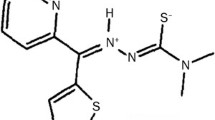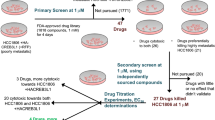Summary
The effects of anticalmodulin agents, namely trifluoperazine (TFP) and two naphthalene sulfonamide derivatives (W-7 and W-13), were tested on the growth of a human breast cancer cell line (MDA-MB-231) using a soft agar clonogenic assay. The results of this in vitro study reveal that TFP, W-7, and W-13 had the ability to inhibit the colony formation from this cell line. The inhibitory effect was greater when the cancer cells were exposed to these agents continuously than when the cells were exposed to the drugs for 1 h. The IC50 values for TFP, W-7, and W-13 in continuous exposure were about 18, 30, and 38 μM, respectively, whereas the corresponding values for 1-h exposure were 50, 53, and 70 μM, respectively. These findings suggest that anticalmodulin agents can inhibit the growth of human cancer cells at relatively low concentrations in vitro. Whether effective antitumor concentrations of these drugs can be achieved in vivo remains a subject for further study.
Similar content being viewed by others
References
Belkin M, Hardy WG (1957) Effect of reserpine and chlorpromazine on sarcoma 37. Science 125:233–234
Boynton AL, Whitfield JF, MacManus JP (1980) Calmodulin stimulates DNA synthesis by rat liver cells. Biochem Biophys Res Commun 95:745–749
Brinkley BR, Beall PT, Wible LJ, Mace ML, Turner DS, Cailleau RM (1980) Variations in cell form and cytoskeleton in human breast carcinoma cells in vitro. Cancer Res 40:3118–3129
Cailleau R, Young R, Olive M, Reeves WJ Jr (1974) Breast tumor cell lines from pleural effusions. J Natl Cancer Inst 53:661–674
Chafouleas JG, Pardue RL, Brinkley BR, Dedman JR, Means AR (1981) Regulation of intracellular levels of calmodulin and tubulin in normal and transformed cells. Proc Natl Acad Sci USA 78:996–1000
Chafouleas JG, Bolton WE, Hidaka H, Boyd AE, Means AR (1982) Calmodulin and the cell cycle: Involvement in regulation of cell-cycle progression. Cell 28:41–50
Chorazy M (1959) Effect of chlorpromazine on Crocker sarcoma and Ehrlich ascites carcinoma. Nature 184:200–201
Cranston EM (1958) Effects of some tranquilizers on a mammary adenocarcinoma in mice. Cancer Res 18:897–899
Criss WE, Kakiuchi S (1982) Calcium: Calmodulin and cancer. Fed Proc 41:2289–2291
Durham ACH, Walton JM (1982) Calcium ions and the control of proliferation in normal and cancer cells. Biosci Rep 2:15–30
Hamburger AW, Salmon SE (1977) Primary bioassay of human tumor stem cells. Science 197:461–463
Hickie RA, Kalant H (1967) Calcium and magnesium content of rat liver and Morris hepatoma 5123 t.c. Cancer Res 27:1053–1057
Hidaka H, Asano M, Tanaka T (1981a) Activity-structure relationship of calmodulin antagonists-naphthalene sulfonamide derivatives. Mol Pharmacol 20:571–578
Hidaka H, Sasaki Y, Tanaka T, Endo T, Ohno S, Fujii Y, Nagata T (1981b) N-(6-aminohexyl)-5-Chloro-1-naphthalene sulfonamide, a calmodulin antagonist, inhibits cell proliferation. Proc Natl Acad Sci USA 78:4354–4357
LaPorte DC, Gidwitz S, Weber MJ, Storm DR (1970) Relationship between changes in the calcium-dependent regulatory protein and adenylate cyclase during viral transformation. Biochem Biophys Res Commun 86:1169–1177
Levin RM, Weiss B (1977) Binding of trifluoperazine to the calcium-dependent activator of cyclic nucleotide phosphodiesterase. Mol Pharmacol 13:690–697
MacManus JP, Boynton AL, Whitfield JF (1978) Cyclic AMP and calcium as intracycle regulators in the control of cell proliferation. Adv Cyclic Nucleotide Res 9: 485–491
MacManus JP, Braceland BM, Rixon RH, Whitfield JF, Morris HP (1981) An increase in calmodulin during growth of normal and cancerous liver in vivo. FEBS Lett 133:99–102
Pisciotta AV (1965) Studies on a granulocytosis VII limited proliferative potential of chlorpromazine-sensitive patients. J Lab Clin Med 65:240–247
Pitot HC (1981) Fundamentals of oncology, 2nd edn. Marcel Dekker, New York p 19
Prozialek WC, Weiss B (1982) Inhibition of calmodulin by phenothiazines and related drugs: Structure-activity relationships. J Pharmacol Exp Ther 222:509–516
Salmon SE (1980) Application of the human tumor stem cell assay to new drug evaluation and screening. In: Salmon SE (ed) Cloning of human tumor stem cells, chap 22. Alan Liss, New York, pp 291–314
Sasaki Y, Hidaka H (1982) Calmodulin and cell proliferation. Biochem Biophys Res Commun 104:451–456
Singer AL, Sherwin RP, Dunn AS, Appleman MM (1976) Cyclic nucleotide phosphodiesterase in neoplastic and non-neoplastic human mammary tissues. Cancer Res 36:60–66
Van Woert MH, Palmer SH (1969) Inhibition of the growth of mouse melanoma by chlorpromazine. Cancer Res 29:1952–1955
Watterson DM, Van Eldik LJ, Smith RE, Vanaman TC (1976) Calcium-dependent regulatory protein of cyclic nucleotide metabolism in normal and transformed chicken embryo fibroblasts. Proc Natl Acad Sci USA 73:2711–2715
Wei JW, Hickie RA (1981) Increased content of calmodulin in Morris hepatoma 5123t.c.(h). Biochem Biophys Res Commun 100:1562–1568
Wei JW, Morris HP, Hickie RA (1982) Positive correlation between calmodulin content and hepatoma growth rates. Cancer Res 42:2571–2574
Weiss B, Prozialeck WC, Wallace TL (1982) Interaction of drugs with calmodulin: biochemical, pharmacological and clinical implications. Biochem Pharmacol 31:2217–2226
Whitfield JF, Boynton AL, MacManus JP, Rixon RH, Sikorska M, Tsang B, Walker PR, Swierenga SHH (1980) The roles of calcium and cyclic AMP in cell proliferation. Ann NY Acad Sci 339:216–240
Author information
Authors and Affiliations
Rights and permissions
About this article
Cite this article
Wei, JW., Hickie, R.A. & Klaassen, D.J. Inhibition of human breast cancer colony formation by anticalmodulin agents: Trifluoperazine, W-7, and W-13. Cancer Chemother. Pharmacol. 11, 86–90 (1983). https://doi.org/10.1007/BF00254251
Received:
Accepted:
Issue Date:
DOI: https://doi.org/10.1007/BF00254251




